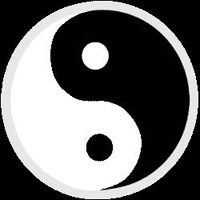Taoism at a Glance

Centered around the birth of all creation from the Divine Mother. Lao-tzu wrote of an ancient time when the feminine principle was not yet dominated by the masculine:
“There was something complete and nebulous
Which existed before Heaven and Earth,
Silent, invisible,
Unchanging, standing as One,
Unceasing, ever-revolving,
Able to be the Mother of the World.
I do not know its name and I call it Tao.”
Tao Te Ching, 26
Taoism acknowledges that the cyclical changes in the human body and the changing aspects of nature are intimately related. Through careful observation of the natural world and insights gained in deep meditative trance, the early Chinese sages developed the concept of yin-yang, opposing forces that complement each other and, through their interaction, give rise to the rest of the phenomenal world, or what the ancients called “the ten thousand things.” In this polarity, the male generative principle of yang is represented by the sun (day) and the heavens, and the female life-bearing powers of yin by the moon (night) and the earth. Their interplay creates the Five Elements (water, fire, wood, metal, earth), which are emblematic of the changing seasons, the four cardinal directions plus the center, the five senses, and much more. Likewise, Taoists relate the microcosm of the human body to the macrocosm of the world (earth, heavens, and underworld). Together, the opposing principles of yin-yang and the cyclical interplay of the five elements, along with the mirroring of the cosmos in the body, contain the essence of Chinese spirituality.
These basic principles, however, have manifested over many centuries in a bewildering array of Taoist schools and practices, and were further modified by contact with Buddhist missionaries from India. As a practice, Taoism became organized in the 4th and 3rd centuries BCE, based on the writings of two men. The Tao Te Ching is usually attributed to Lao-tzu, who is said to have been born around 600 BCE, but whose dates are uncertain and whose authorship of the book has been questioned. There is even a story, perhaps apocryphal, that Lao-tzu once met with Confucius, who lived between 551 and 479. Lao-tzu’s work was commented on and expanded by Chuang-tzu (c. 369-286 BCE), who was also a critic of Confucius.
Taoists themselves insist that these principles derive from the oral teachings of sages as far back in history as 5000 years ago, which would make Taoism at least as old as Vedic Hinduism. Whether the early Taoists were influenced by migrating Indian sages or discovered similar insights in their own pursuit of meditative states is less important than understanding that Taoism developed along different lines from the Indian traditions. It has certain aspects in common with those traditions, yet is distinctively Chinese. In turn it exerted a major influence on Buddhism as that Indian-born religion passed through China on its way East.
Next – Philosophical and Religious Taoism »


